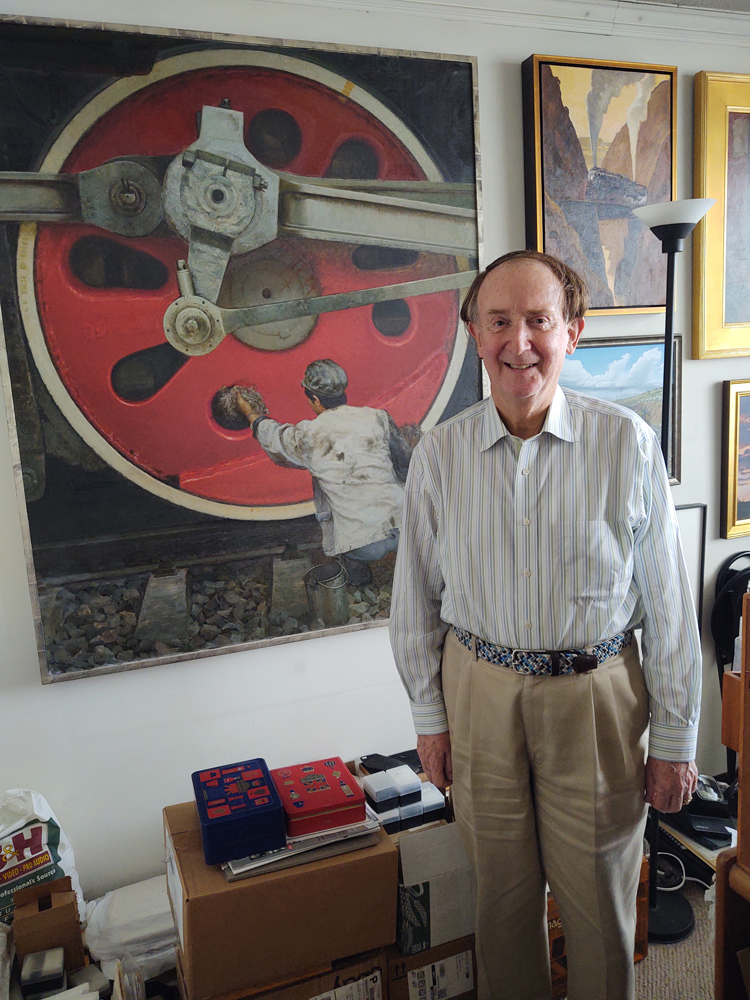
MADISON, Wis. — A longtime collector of worldwide railroad art has announced the donation of 250 pieces amassed over the last 40 years to the Center for Railroad Photography & Art.
Peter Mosse, a CRP&A board member since 2016, and his wife Christine offered the collection to the center, which announced its acceptance at its recent Conversations conference at Lake Forest College in suburban Chicago.
Founded in 1997 by noted railroad photographer John E. Gruber, the Center gathers important collections, publishes books and a periodical, and sponsors traveling exhibitions. Until now, it has concentrated on archiving, conserving, and showcasing photographic images. While it has collected art prints, this gift of original art broadens its scope exponentially.
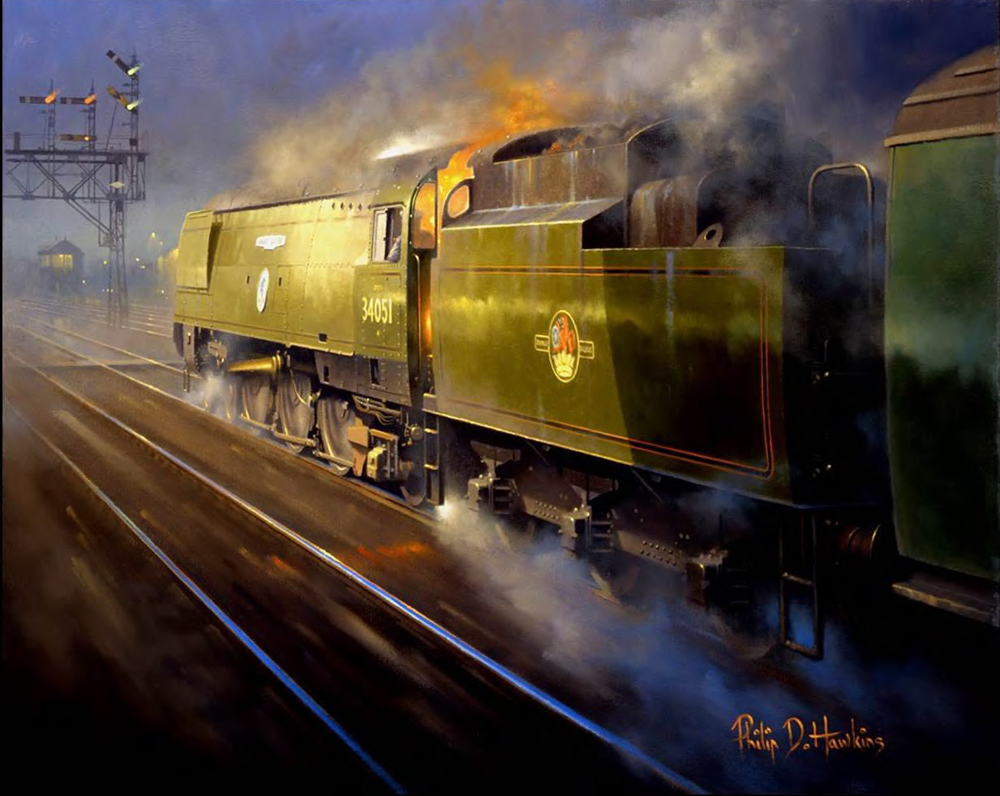
“With the single addition of the Peter and Christine Mosse Art Collection, we will go from having a modest representation of railroad paintings in our archive to a truly world-class collection,” said CRP&A President and Executive Director Scott Lothes. “We are thrilled and humbled by their generosity and confidence.
“The transfer will be happening at a later date (or dates) of Peter and Christine’s choosing, which could be many years down the road,” Lothes said. “We still don’t plan to open a gallery in Madison, but we’re eagerly thinking of possible traveling exhibitions we could assemble with selections from the collection. We’ll be able to share digital images of many of these works, too, subject to copyright and the artists’ wishes.”
Discarding the idea of parceling out individual pieces to mainstream and railroad museums, Mosse said he elected to keep the collection intact because “its key attribute [is] its diversity across time, artistic styles, and countries of origin, unified solely by the subject.”
He chose CRP&A because “it was the only organization I could think of whose mission aligned perfectly with what I had been doing.”
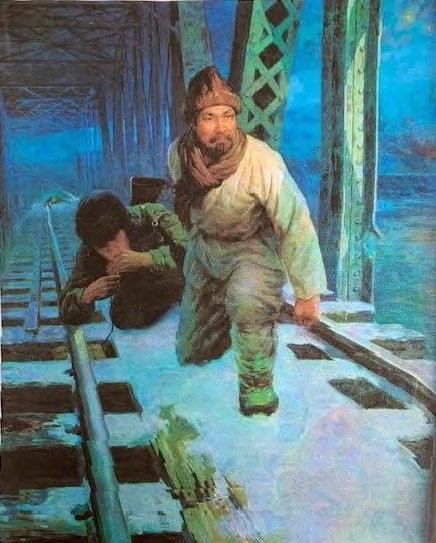
CRP&A Chairman Bon French told News Wire, “It’s beyond exciting. I think, clearly, it’s going to open up opportunities to work with mainstream galleries and art museums around the country, and beyond, that are not otherwise necessarily railroad oriented.”
The artwork portrays railroad scenes from 26 countries. Subjects include not only trains but also stations, yards, shops and roundhouses, passengers, and railroad workers of all crafts. Artistic styles range from almost photographic realism, to soft, impressionistic scenes, to whimsical designs, to images steeped in eclectic fantasy.
“The breadth of the collection is fantastic,” said French. “The global scope is fantastic.”
Born in 1947, Mosse grew up in England, acquiring his first British trainspotter’s locomotive guide in 1955. As a teen, he worked during school breaks in the stationmaster’s office of London’s Paddington Station. After graduating from Oxford University and obtaining an MBA from the Wharton School at the University of Pennsylvania, he entered a career in banking and commodities trading with the English Rothschild family, from which he retired a few years ago. His wife is a retired physician who maintained her own practice in New York City.
While Mosse spent most of his life and career in the United States, his personal and business travels have taken him around the world, giving him a global perspective that is evident in the wide range of scenes he’s collected.
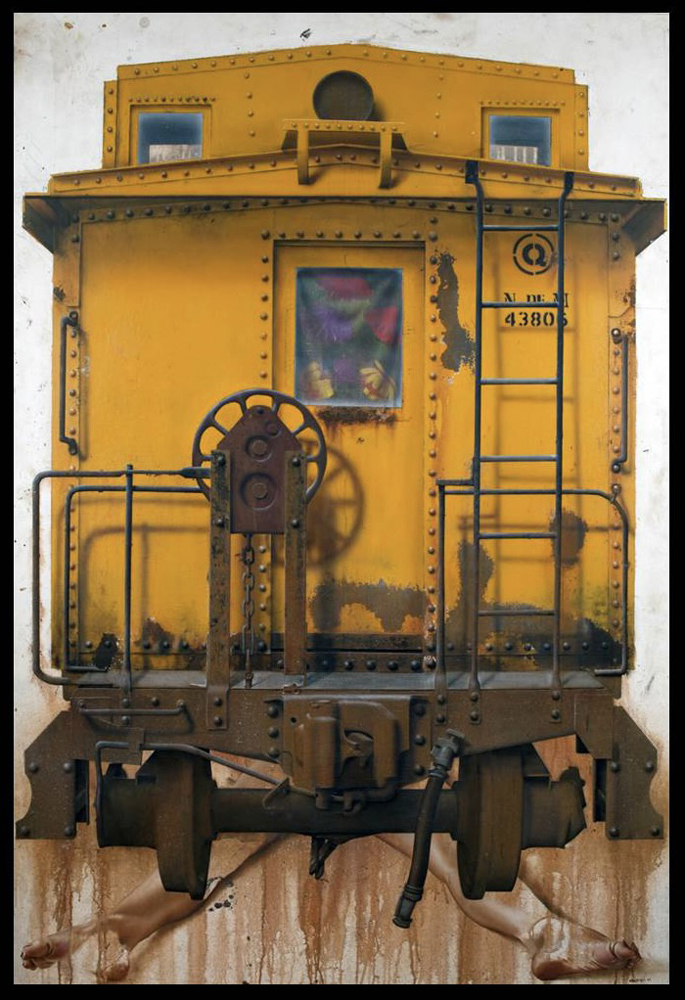
Most of the pieces are oil-on-canvas paintings, but other types include oil on board, watercolors on paper, pen-and-ink, graphite on paper and mixed media. They range from the very small (3 x 7 inches, showing a railway in South London, by English artist John Parks) to the wall-sized (a nearly 4-x-6-foot, mixed-media 1990 painting titled Yellow Caboose by Mexican artist Rafael Cauduro).
About 160 pieces are displayed on the walls of the couple’s Upper East Side high-rise apartment in Manhattan.
Mosse emphasizes that he never intended to start collecting art, and when he did, it was for personal enjoyment, not as an investment. An aunt’s gift of a watercolor provided the seed that prompted his first purchase from a New York gallery, about 1980. That led to visits to Sotheby’s and Christie’s upscale auction houses, and to art magazines and searches across internet listings.
Most of the art is original. “I have very little in the way of reproduced art, [though I] do have some prints, probably six Currier & Ives pieces,” said Mosse. Also in this category are “propaganda posters, from countries where I wasn’t able to get original art, such as Vietnam and the Soviet Union, and copies of posters which were in themselves original items, such as North Korea.”
The earliest piece is an Italian pencil-and-watercolor scene by German artist Georg Busse, Scene Near Castellammare with Vesuvius in the Distance, dated 1843. The most recent is a 20-by-20-inch oil painting by Charlie Hunter, Semaphore, from 2022.
Among widely known names represented in the collection are John Austin of the United Kingdom; Terence Cuneo (1907-1996), the dean of railway artists in the U.K; Walter L. Greene, known for New York Central calendar scenes; Phil Hawkins of the U.K.; industrial designer Otto Kuhler; Maurice Logan, a California artist who did a poster for Southern Pacific; Reginald Marsh, best known for depictions of New York City life; watercolorist Ted Rose; Grif Teller, known for Pennsylvania Railroad calendar paintings; Craig Thorpe, known for Pacific Northwest and Amtrak paintings; and David Tutwiler, known for work with the Disney Co. and “Star Wars” Producer George Lucas.
Mosse visited Tutwiler’s gallery, then located in Rockport, Mass., several times, and added to his collection the artist’s Symphony of the East Wind, which depicts the passenger train of that name at the Bar Harbor ferry landing in Maine.
Mosse has commissioned work, including two pieces from Cuneo, whom he calls “the gold standard as far as U.K. railway artists are concerned.” He noted that Cuneo is “one of the few that have moved into the mainstream” of art circles, one piece having recently sold for £45,000 ($55,876).
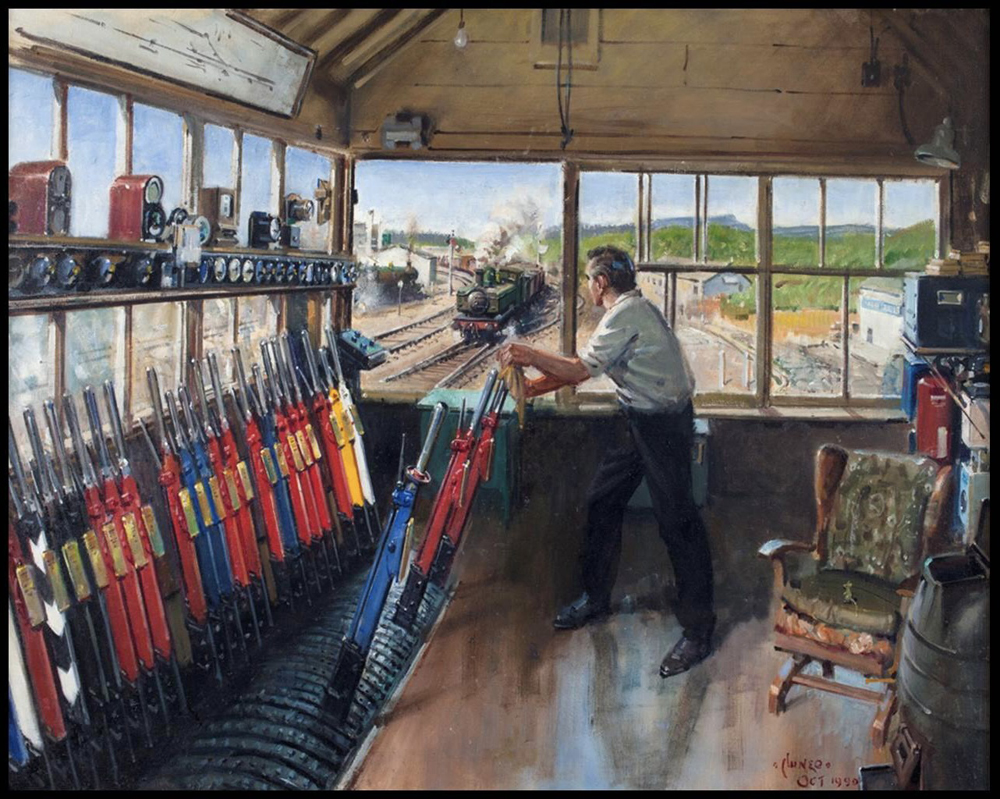
The most notable commission in Mosse’s collection is Cuneo’s Lostwithiel Crossing Signal Box (oil on canvas, 24 x 30 inches, 1990). Having known Cuneo’s work on a popular series of British Railways posters, he approached the artist with a concept of combining a setting of Victorian-era technology (the signal box, or, in American terms, interlocking tower) contrasting with a modern Inter-City 125 high-speed diesel trainset. Cuneo, preferring the nostalgia of steam locomotives, talked his client into agreeing to that change, inserting a steam-hauled goods (freight) train instead of a sleek British Rail passenger train.
“I’m prepared to concede that visually it’s more appealing but slightly less interesting than it would have been with a diesel train,” Mosse said.
The most striking painting in the collection, he says, is Polishing, by Chinese artist Zhong Li Gong, (1984, oil on canvas, 55 x 45 inches). It depicts a worker next to a large steam-engine driving wheel, with part of the valve gear showing. He spotted it in a Madison Avenue gallery in 1987. “When I saw this painting it stopped me dead in my tracks,” he said, but two obstacles presented themselves. Another collector had placed a hold on it, and “I was convinced that it was far too large for my apartment,” Mosse said.
Through a series of circumstances, the other buyer withdrew, Mosse eventually realized that it would fit his quarters, and he bought it. “That turned out, without doubt, to be the most popular painting in the collection in terms of visitor response,” he said. “Everybody who sees it remembers it.”
Why? “Size is part of it,” he said. “It’s dramatic, the colors are wonderful, and it speaks to something about the relationship between man and machine.”
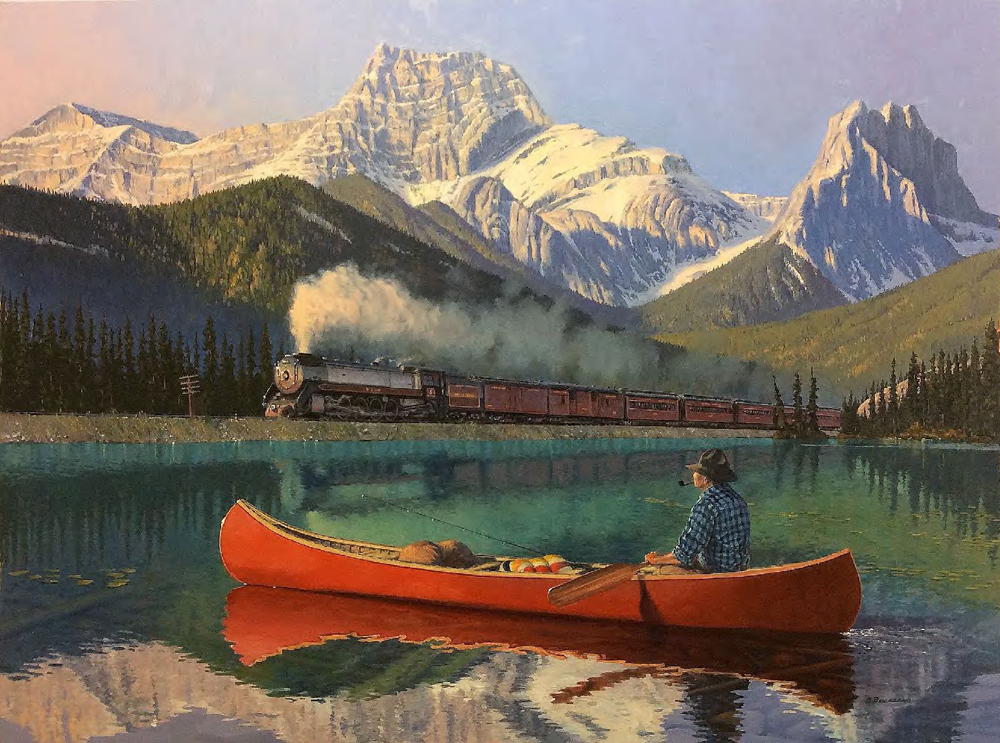














One cannot praise the CRP&A enough; from the foresight shown by John Gruber down to the present. What strikes me about this current donation of art is the next step needed…like the MSOE’s Grohman museum the Center needs its own display space!
I encourage readers to become members. The quarterly publication is worth more than the price of admission.
i agree with curtis. Art is a storae closet is not where art should be. CRP&A should start looking for a gallery space where everyone can enjoy this valuable collection, as well as the many photos it has. I am sure there might be a wealthy donor out there who has a building, or maybe the railroads would kick in some $$, or a unused building somewhere, to provide an uplifting experince for our important industry. Thank you Mr. Mosse for your gift to the indstry.
This is easily the most uplifting news I’ve seen on News Wire in a long time. Touring exhibitions seem very achievable for CRP&A and I look forward to seeing some part of this collection appear out west!